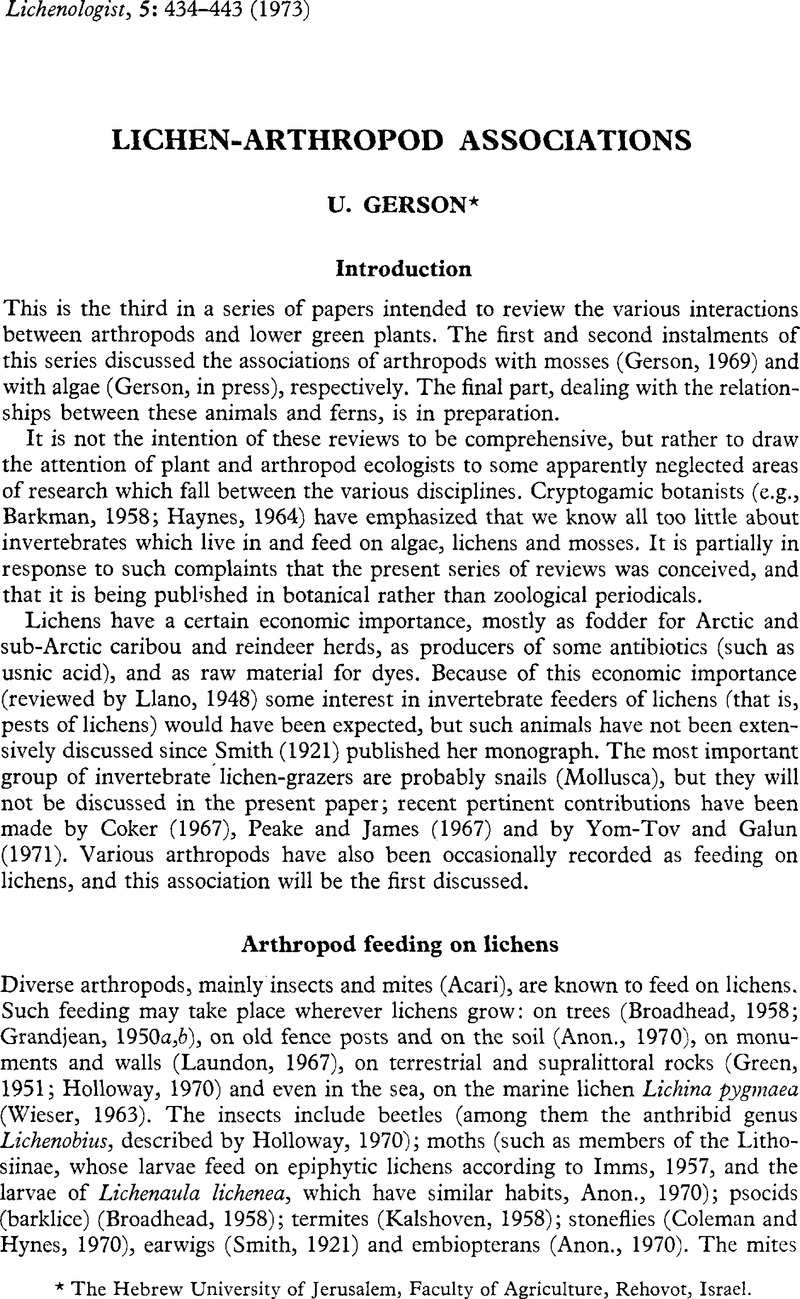Crossref Citations
This article has been cited by the following publications. This list is generated based on data provided by
Crossref.
Poelt, Josef
1974.
Fortschritte der Botanik.
Vol. 36,
Issue. ,
p.
263.
Gilbert, O.L.
and
Wathern, P.
1976.
The flora of the Flannan Isles.
Transactions of the Botanical Society of Edinburgh,
Vol. 42,
Issue. 4,
p.
487.
Rundel, Philip W.
1978.
The ecological role of secondary lichen substances.
Biochemical Systematics and Ecology,
Vol. 6,
Issue. 3,
p.
157.
SEYD, EDMUND L.
and
SEAWARD, MARK R. D.
1984.
The association of oribatid mites with lichens.
Zoological Journal of the Linnean Society,
Vol. 80,
Issue. 4,
p.
369.
André, H. M.
1985.
Associations between corticolous microarthropod communities and epiphytic cover on bark.
Ecography,
Vol. 8,
Issue. 2,
p.
113.
Armstrong, R.A.
1987.
Dispersal in a population of the lichen Hypogymnia physodes.
Environmental and Experimental Botany,
Vol. 27,
Issue. 3,
p.
357.
Baur, Anette
Baur, Bruno
and
Fr�berg, Lars
1994.
Herbivory on calcicolous lichens: different food preferences and growth rates in two co-existing land snails.
Oecologia,
Vol. 98,
Issue. 3-4,
p.
313.
Walser, J.‐C.
Zoller, S.
Büchler, U.
and
Scheidegger, C.
2001.
Species‐specific detection ofLobaria pulmonaria(lichenized ascomycete) diaspores in litter samples trapped in snow cover.
Molecular Ecology,
Vol. 10,
Issue. 9,
p.
2129.
Lalley, J.S.
Viles, H.A.
Henschel, J.R.
and
Lalley, V.
2006.
Lichen-dominated soil crusts as arthropod habitat in warm deserts.
Journal of Arid Environments,
Vol. 67,
Issue. 4,
p.
579.
Ulyshen, Michael D.
2011.
Arthropod vertical stratification in temperate deciduous forests: Implications for conservation-oriented management.
Forest Ecology and Management,
Vol. 261,
Issue. 9,
p.
1479.
BATES, Scott T.
BERG-LYONS, Donna
LAUBER, Christian L.
WALTERS, William A.
KNIGHT, Rob
and
FIERER, Noah
2012.
A preliminary survey of lichen associated eukaryotes using pyrosequencing.
The Lichenologist,
Vol. 44,
Issue. 1,
p.
137.
SWEETWOOD, Garrett
LÜCKING, Robert
NELSEN, Matthew P.
and
APTROOT, André
2012.
Ascospore ontogeny and discharge in megalosporousTrypetheliaceaeandGraphidaceae(Ascomycota: Dothideomycetes and Lecanoromycetes) suggest phylogenetic relationships and ecological constraints.
The Lichenologist,
Vol. 44,
Issue. 2,
p.
277.
Smith, Robert J.
Benavides, Juan C.
Jovan, Sarah
Amacher, Michael
and
McCune, Bruce
2015.
A rapid method for landscape assessment of carbon storage and ecosystem function in moss and lichen ground layers.
The Bryologist,
Vol. 118,
Issue. 1,
p.
32.
Zedda, Luciana
and
Rambold, Gerhard
2015.
Recent Advances in Lichenology.
p.
121.
Bokhorst, Stef
Asplund, Johan
Kardol, Paul
and
Wardle, David A.
2015.
Lichen physiological traits and growth forms affect communities of associated invertebrates.
Ecology,
Vol. 96,
Issue. 9,
p.
2394.
Asplund, Johan
Bokhorst, Stef
Kardol, Paul
and
Wardle, David A.
2015.
Removal of secondary compounds increases invertebrate abundance in lichens.
Fungal Ecology,
Vol. 18,
Issue. ,
p.
18.
Nabozhenko, M. V.
Keskin, B.
and
Nabozhenko, S. V.
2017.
Life forms and strategies of lichen-feeding darkling beetles (Coleoptera, Tenebrionidae: Helopini).
Entomological Review,
Vol. 97,
Issue. 6,
p.
735.
Medeiros, Ian D.
Kraichak, Ekaphan
Lücking, Robert
Mangold, Armin
and
Lumbsch, H. Thorsten
2017.
Assembling a Taxonomic Monograph of Tribe Wirthiotremateae (Lichenized Ascomycota: Ostropales: Graphidaceae).
Fieldiana Life and Earth Sciences,
Vol. 9,
Issue. ,
p.
1.
Shin, Caren P.
Hoffman, Abby
Lee, Wanyi
Kendrick, Roger C.
Baker, David M.
and
Bonebrake, Timothy C.
2018.
Stable isotopes of Lithosiini and lichens in Hong Kong show the biodindicator potential of lichenivorous moths.
Journal of Asia-Pacific Entomology,
Vol. 21,
Issue. 4,
p.
1110.
Gadea, Alice
Le Lamer, Anne-Cécile
Le Gall, Sophie
Jonard, Catherine
Ferron, Solenn
Catheline, Daniel
Ertz, Damien
Le Pogam, Pierre
Boustie, Joël
Lohézic - Le Devehat, Françoise
and
Charrier, Maryvonne
2018.
Intrathalline Metabolite Profiles in the Lichen Argopsis friesiana Shape Gastropod Grazing Patterns.
Journal of Chemical Ecology,
Vol. 44,
Issue. 5,
p.
471.


